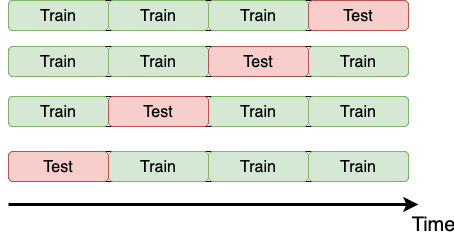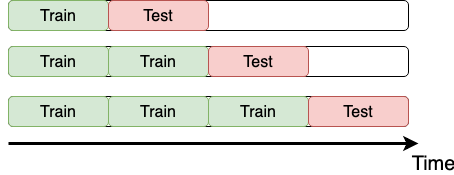Validation usage
Winning a Kaggle Competition in Python

Yauhen Babakhin
Kaggle Grandmaster
Data leakage

Leak in features – using data that will not be available in the real setting
Leak in validation strategy – validation strategy differs from the real-world situation
Time data

Time K-fold cross-validation

Time K-fold cross-validation
# Import TimeSeriesSplit
from sklearn.model_selection import TimeSeriesSplit
# Create a TimeSeriesSplit object
time_kfold = TimeSeriesSplit(n_splits=5)
# Sort train by date
train = train.sort_values('date')
# Loop through each cross-validation split
for train_index, test_index in time_kfold.split(train):
cv_train, cv_test = train.iloc[train_index], train.iloc[test_index]
Validation pipeline
# List for the results fold_metrics = []for train_index, test_index in CV_STRATEGY.split(train): cv_train, cv_test = train.iloc[train_index], train.iloc[test_index]# Train a model model.fit(cv_train)# Make predictions predictions = model.predict(cv_test)# Calculate the metric metric = evaluate(cv_test, predictions) fold_metrics.append(metric)
Model comparison
| Fold number | Model A MSE | Model B MSE |
|---|---|---|
| Fold 1 | 2.95 | 2.97 |
| Fold 2 | 2.84 | 2.45 |
| Fold 3 | 2.62 | 2.73 |
| Fold 4 | 2.79 | 2.83 |
Overall validation score
import numpy as np
# Simple mean over the folds
mean_score = np.mean(fold_metrics)
# Overall validation score
overall_score_minimizing = np.mean(fold_metrics) + np.std(fold_metrics)
# Or
overall_score_maximizing = np.mean(fold_metrics) - np.std(fold_metrics)
Model comparison
| Fold number | Model A MSE | Model B MSE |
|---|---|---|
| Fold 1 | 2.95 | 2.97 |
| Fold 2 | 2.84 | 2.45 |
| Fold 3 | 2.62 | 2.73 |
| Fold 4 | 2.79 | 2.83 |
| Mean | 2.80 | 2.75 |
| Overall | 2.919 | 2.935 |
Let's practice!
Winning a Kaggle Competition in Python

